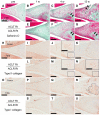The Natural History of Medial Meniscal Tears in the ACL Deficient and ACL Reconstructed Rat Knee
- PMID: 34024166
- PMCID: PMC8804834
- DOI: 10.1177/19476035211014588
The Natural History of Medial Meniscal Tears in the ACL Deficient and ACL Reconstructed Rat Knee
Abstract
Objective: The process of anterior cruciate ligament (ACL) injury-induced meniscal tear formation is not fully understood. Clinical studies have shown that ACL reconstruction (ACLR) reduces the development of secondary meniscal tears, but it is difficult to gain insight into the protective effects of ACLR from clinical studies alone. Using rat ACL transection (ACLT) and ACLR models, we aimed to reveal (1) the formation process of meniscal tears secondary to ACLT and (2) the protective effects of ACLR on secondary meniscal tears.
Design: ACLT surgery alone or with ACLR was performed on the knees of rats. Histomorphological and histopathological changes were examined in the posteromedial region of the meniscus in intact rats and in rats that received ACLT or ACLR up to 12 weeks postsurgery. In addition, anterior-posterior joint laxity was measured using the universal testing machine to evaluate the effects of ACLT and ACLR on joint laxity.
Results: AAnterior-posterior laxity was significantly increased by ACLT compared to the intact knee. This ACLT-induced joint laxity was partially but significantly reduced by ACLR. Meniscal proliferation and hyaline cartilage-like tissue formation were detected in the medial meniscus at 4 weeks post-ACLT. At 12 weeks post-ACLT, hyaline cartilage-like tissue was replaced by ossicles and meniscal tears were observed. These ACLT-induced abnormalities were attenuated by ACLR.
Conclusions: Our results suggest that ACLT-induced joint laxity induces secondary medial meniscal tears through meniscal proliferation and ossicle formation via endochondral ossification. Joint re-stabilization by ACLR suppresses meniscal proliferation and ossicle formation and consequently prevents secondary meniscal tears.
Keywords: anterior cruciate ligament injury; anterior cruciate ligament reconstruction; joint laxity; medial meniscal proliferation; medial meniscal tear; ossicles.
Conflict of interest statement
Figures







Similar articles
-
Incidence and Healing Rates of Meniscal Tears in Patients Undergoing Repair During the First Stage of 2-Stage Revision Anterior Cruciate Ligament Reconstruction.Am J Sports Med. 2019 Dec;47(14):3389-3395. doi: 10.1177/0363546519878421. Epub 2019 Nov 6. Am J Sports Med. 2019. PMID: 31693386
-
Arthroscopic centralization reduces extrusion of the medial meniscus with posterior root defect in the ACL reconstructed knee.Knee Surg Sports Traumatol Arthrosc. 2023 Feb;31(2):543-550. doi: 10.1007/s00167-022-07160-7. Epub 2022 Sep 16. Knee Surg Sports Traumatol Arthrosc. 2023. PMID: 36114341
-
Effect of Meniscocapsular and Meniscotibial Lesions in ACL-Deficient and ACL-Reconstructed Knees: A Biomechanical Study.Am J Sports Med. 2018 Aug;46(10):2422-2431. doi: 10.1177/0363546518774315. Epub 2018 May 30. Am J Sports Med. 2018. PMID: 29847148
-
Single-stage repair of displaced bucket-handle meniscal tears with anterior cruciate ligament reconstruction leads to good meniscal survivorship : a retrospective cohort study.Bone Joint J. 2022 Jun;104-B(6):680-686. doi: 10.1302/0301-620X.104B6.BJJ-2021-1340.R2. Bone Joint J. 2022. PMID: 35638209 Review.
-
Lack of Consensus on the Management of Medial Collateral Ligament Tears in the Setting of Concomitant Anterior Cruciate Ligament Injury: A Critical Analysis.JBJS Rev. 2024 Jun 24;12(6). doi: 10.2106/JBJS.RVW.24.00036. eCollection 2024 Jun 1. JBJS Rev. 2024. PMID: 38913807 Review.
Cited by
-
Effects of Joint Immobilization and Treadmill Exercise on Articular Cartilage After ACL Reconstruction in Rats.Orthop J Sports Med. 2022 Oct 17;10(10):23259671221123543. doi: 10.1177/23259671221123543. eCollection 2022 Oct. Orthop J Sports Med. 2022. PMID: 36276424 Free PMC article.
References
-
- Musahl V, Karlsson J. Anterior cruciate ligament tear. N Engl J Med. 2019;380(24):2341-48. - PubMed
-
- Sonoda M, Harwood FL, Amiel ME, Moriya H, Amiel D. The effects of hyaluronan on the meniscus in the anterior cruciate ligament-deficient knee. J Orthop Sci. 2000;5(2_suppl):157-64. - PubMed
-
- Hagmeijer MH, Hevesi M, Desai VS, Sanders TL, Camp CL, Hewett TE, et al.. Secondary meniscal tears in patients with anterior cruciate ligament injury: relationship among operative management, osteoarthritis, and arthroplasty at 18-year mean follow-up. Am J Sports Med. 2019;47(7):1583-90. - PubMed
-
- Keene GC, Bickerstaff D, Rae PJ, Paterson RS. The natural history of meniscal tears in anterior cruciate ligament insufficiency. Am J Sports Med. 1993;21(5):672-9. - PubMed
Publication types
MeSH terms
LinkOut - more resources
Full Text Sources
Other Literature Sources
Medical

